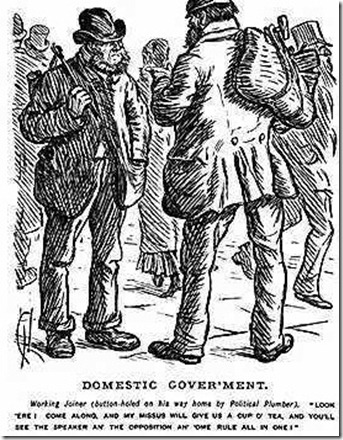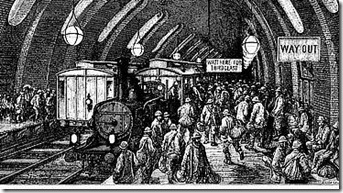Culture and community in the factory became the concern of ‘scientific management’, a comprehensive strategy significantly in advance of the paternalism of the 1850s and 1860s. The working environment improved as employers implemented new factory legislation and extended the range of welfare programmes, but other initiatives were less benevolent. Pioneer forms of Taylorism provided new managerial techniques to raise labour productivity and curb the power of organised labour and were pursued with some vigour as international competition increased and prices fell.[1]
The design and planning of production processes became a managerial prerogative, a task undertaken by new production engineers, while shopfloor operatives were kept under constant surveillance by foremen. This challenged the skilled workers’ belief that they had autonomy in the sphere of production. Supervision was often accompanied by new methods of payment, elaborate incentive schemes such as bonus systems. Employers hoped to effect the maximum division of labour to take advantage of the technological developments of the ‘second industrial revolution’: semi-automatic machines, standardised and interchangeable parts and the increasing use of semi-skilled labour on tasks previously the preserve of a skilled elite.[2] These managerial and technical innovations threatened to undermine skilled status and craft organisations but, in the English context at least, they proved remarkably resilient.
The consequences of attempts to reorganise production varied from industry to industry. Craft organisation remained stronger where employers were hindered by market forces, relative inelasticity of demand for the product or its perishable nature. Hand compositors in the newspaper industry, for example, gained control of the new linotype machines for their own exclusive ‘craft’ use, a privilege extracted from employers in the competitive market for a perishable product.[3] Some employers decided against reorganisation when confronted by the threat of craft resistance. This was a sensible, if short-term, solution for family-owned firms making satisfactory profits. Also the product market for British-made capital goods was often highly individualised, a significant obstacle to the introduction of standardised mass-production techniques: ships, machines, railway engines were constructed to fulfil the individual needs of customers. It was not until the bicycle boom of the mid-1890s that a broad-based demand for a product with standardised parts emerged and at this point engineering employers began to introduce American-style machine tools and lathes.
Mechanisation was implemented in the midst of workplace conflict, as employers combined in a national organisation, the Engineering Employers Federation[4] to reverse the gains secured by the Amalgamated Society of Engineers during the craft militancy of the 1889-1892 boom.[5]
In the lock-out of 1897, the EEF insisted on the absolute right to management but their victory did not mean the crushing of the union or a thorough transformation of the division of labour. The aim of employers was to boost output and reduce labour costs without major capital spending rather than the new rationalising Taylorist mode. Throughout the 1890s there were similar disputes in other major industries as employers reasserted their authority in pursuit of lower labour costs and more efficient use of labour.[6] Between 1892 and 1897 some 13.2 million days were lost through disputes compared to 2.3 million between 1899 and 1907 when new systems of national collective bargaining, similar to those in engineering, took effect. [7] Conflict was particularly intense in the coalfields.[8] The collective bargaining arrangements of the 1890s, the outcome of national strikes and lock-outs, recognised and confirmed the role and functions of craft trade unions, while also making clear the power and prerogatives of employer authority. The compromise workplace relationships of the 1850s and 1860s were reconstructed in different forms.
Skilled workers had to resolve whether they could or should retain their exclusive status. Some workers were prepared to shed some of their exclusivism to strengthen their position against modernising employers. The aristocratic boilermakers set the example, preventing a major reorganisation of steel ship production by a flexible union policy that kept the boundaries of membership under constant review. When the need arose, semi-skilled workers central to production were granted membership, an important step towards the establishment of a virtual closed shop. Attitudes to unskilled workers depended on circumstances: some were admitted, others were not. This redefinition of their boundaries of exclusion to admit previously prohibited groups of workers proved highly effective in allowing skilled workers to retain their aristocratic status in the new conditions of late-Victorian England. It helps to explain why the Alliance Cabinet-Makers’ Association succeeded while the older Friendly Society of Operative Cabinet-Makers withered away into narrow craft restrictionism.[9] Old-fashioned prejudice was probably most difficult to abandon where gender was concerned. Craft organisation in the Potteries remained narrow and sectional, powerless to prevent displacement as cheap female labour was put to work on new machines.[10]
The persistence of exclusive status reflecting the interplay between ‘genuine skill’ (a necessary exercise of dexterity, judgment and knowledge) and ‘socially constructed skill’ (the specious status upheld by organisational control).[11] Managerial control was exerted over the technical expertise previously located on the shopfloor. A distinction emerged between planning and execution, the implementation of which depended on supervisory workers, trained technicians who owed their position to knowledge acquired at night school. Shopfloor skills were increasingly limited and specialised despite the continued existence of apprenticeship that passed on knowledge of the trade. Formal, indentured arrangements in the older crafts steadily declined but apprenticeship expanded in several growing industries like building[12] and printing[13], where there was considerable agreement between employers and workers over training methods. With the greater specialisation of work and skill, apprentice labour was quickly turned to profit by employers, a source of cheap labour that, as earlier in the century, undermined the position of adult men in the labour market. [14]
[1] ‘Taylorism’ originated in the United States and represented the logical development of the concept of the division of labour. The different aspects of manufacture were identified and then applied to an assembly line structure. See, Taylor, Frederick Winslow, The principles of scientific management, (Harper & Brothers), 1911 and Hounshell, David A., From the American System to Mass Production, 1800-1932: The Development of Manufacturing Technology in the United States, (JHU Press), 1985.
[2] See, Zeitlin, Jonathan, ‘The meaning of managerial prerogative: industrial relations and the organisation of work in British engineering, 1880-1939’, in Harvey, Charles E. and Turner, John, (eds.), Labour and business in modern Britain, 1989, pp. 32-47.
[3] See, Duffy, Patrick, The skilled compositor, 1850-1914: an aristocrat among working men, (Ashgate), 2000.
[4] Zeitlin, Jonathan, ‘The internal politics of employer organization: the Engineering Employers’ Federation, 1896-1939’, in Tolliday, Steven and Zeitlin, Jonathan, (eds.), The Power to Manage?: Employers and Industrial Relations in Comparative Historical Perspective, (Routledge), 1991, pp. 46-70 especially 47-55.
[5] Burgess, K., ‘New Unionism for old? The Amalgamated Society of Engineers in Britain’, in Mommsen, W.J. and Husung, H.-G., (eds.), The development of trade unionism in Great Britain and Germany, 1880-1914, (German Historical Institute), 1985, pp. 166-184.
[6] This is evident in Smith, D.N., ‘Managerial strategies, working conditions and the origins of unionism: the case of the tramway and omnibus industry, 1870-91’, Journal of Transport History, 3rd ser., Vol. 8, (1987), pp. 30-51 and Lester, V. Markham, ‘The employers’ liability/workmen’s compensation debate of the 1890s revisited’, Historical Journal, Vol. 44, (2001), pp. 471-495.
[7] Cronin, James E., ‘Strikes 1870-1914’, in Wrigley, Chris, (ed.), A history of British industrial relations, Vol. 1: 1875-1914, (Harvester), 1982, pp. 74-98.
[8] Church, Roy A. and Outram, Quentin, Strikes and Solidarity: Coalfield Conflict in Britain, 1889-1966, (Cambridge University Press), 2002, pp. 38-58, 95-112.
[9] Betjemann, Peter, ‘Craft and the Limits of Skill: Handicrafts Revivalism and the Problem of Technique’, Journal of Design History, Vol. 21, (2008), 183-193.
[10] Anderson, G., ‘Some aspects of the labour market in Britain 1870-1914’, ibid, Wrigley, Chris, (ed.), A history of British industrial relations, Vol. 1: 1875-1914, pp. 1-19.
[11] Griffiths, Trevor, The Lancashire working classes: c.1880-1930, (Oxford University Press), 2001 is an excellent case-study.
[12] Powell, Christopher G., The British building industry since 1800: an economic history, 2nd ed., (Spon), 1996, pp. 74-98.
[13] Skingsley, T.A., ‘Technical training and education in the English printing industry: a study of late 19th century attitudes’, Journal of the Printing Historical Society, Vol. 13, (1978-9), pp. 1-25; Vol. 14, (1979-80), pp. 1-58.
[14] See, for example, Wilcox, Martin, ‘Opportunity or Exploitation? Apprenticeship in the British Trawl Fisheries, 1850-1936’, Genealogists’ Magazine, Vol. 28, (2004), pp. 135-149.


No comments:
Post a Comment